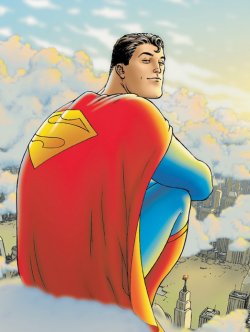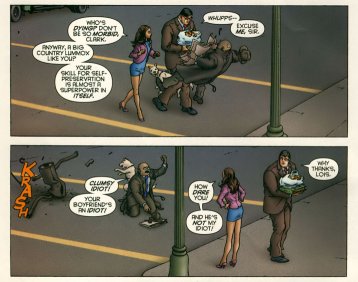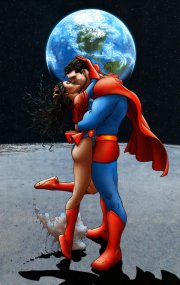All-Star Superman #1-3
No Panel Beating proper from me this week; blame it on a quite uninspiring week of comics. The soon-to-be-cancelled Manhunter was a bit dull, 52 was a vast improvement on last week but has still yet to get really exciting (tell you what, though, I'd put money on "Booster Gold" not actually being who we think he is), Green Arrow was an entertaining issue-long fight scene but was really rather lightweight, and I didn't even get Robin, because my comic shop told me it didn't come out. Even though it did. Bah.
Anyway, in the absence of anything particularly exciting to say, I've decided to polish off something I meant to do a while back - an overview of the three issues so far of the best superhero comic that's been published in a very long time - Grant Morrison and Frank Quitely's All-Star Superman.
Superman #1-3
Publisher DC (All-Star line) • Writer Grant Morrison • Pencils Frank Quitely • Digital Inks/Colours Jamie Grant
I can't make any claims towards impartiality here. I love Superman. I love big, stupid, whacked-out, silly Silver Age Superman stories. I love Grant Morrison and I love Frank Quitely, and I love them together even more than I love them individually. So really, as you can probably imagine, the idea of Glasgow's finest collaborating to tell a big, stupid, whacked-out, silly Silver Age-style Superman story is something that appeals to me just a teeny tiny bit. It's like someone looked inside my brain and scooped out all the elements that would go towards making my dream comic. It's fair to say I was looking forward to this one quite a bit.
And yet, all of that said, I still couldn't have predicted how good this would turn out to be. If you're a fan of the gloriously out-there stories of the late '50s and early '60s, then this is going to stand for you as one of the best Superman comics of the contemporary era. And even if you're not, then from a purely technical standpoint it's a masterpiece of craftsmanship.
 |
The pacing, for starters, works beautifully. Unlike Frank Miller's All-Star Batman & Robin, which is a single story told over twelve issues, All-Star Superman is twelve standalone stories with an underlying arc. In other words, it's paced exactly like a TV series - indeed, the credits at the end of each issue suggest that this is a tone that Grant and Frank are aiming for. The underrunning story is, inherently, a quite simple one. Superman discovers in the first issue that he's dying - after having flown through the sun while rescuing some scientists, his powers have been amplified to an incredible degree, but the cells in his body are also breaking down, and he doesn't have long to live. This prompts him, in a surprising twist at the end of the first issue, to reveal his identity to Lois Lane (a much-publicised aspect of this series is that it draws from "classic" continuity, and so Lois and Clark are not married). Lois, meanwhile, is more than happy to be wooed by Superman, but refuses to believe that he actually is Clark Kent, mainly because she spent so long suspecting it only to have it "disproven" time and time again. Around that story, then, each individual issue highlights one of the "twelve labors" that (we learn from sources in the future) he is historically fated to carry out before his death. Simple as that.
When the All-Star line was announced, the idea that got people salivating was that these would be "classic" or "iconic" takes on the characters, cherry-picking the more timeless aspects from seventy-odd years of history and moulding them into an all-new set of stories set in the modern day, appealing to both the casual reader and the long-time fan. These stories would have no ties to existing continuities, nor would they be an Ultimate style attempt to create brand new, parallel versions of the characters with altered origin stories. Unfortunately, expectations of what the line would be were quickly dashed when it turned out that with All-Star Batman & Robin The Boy Wonder, Frank Miller had instead decided to write Batman : Year Two, turning Bruce Wayne into an out-of-control, immature jerk, who has essentially kidnapped a terrified Grayson moments after the death of his parents. Rather than combining past elements, it's instead an entirely new interpretation of the Dark Knight's early years, essentially played as Sin City with lots of Jim Lee-drawn tits and arse shots. And at the time of writing, it's taken four issues for Batman to drive Dick Grayson to the Batcave, and hasn't even put the latter - one of its title characters, lest we forget - in costume yet.
Compare this latter point with the opening of All-Star Superman #1. One page, four panels. "Doomed planet. Desperate Scientists. Last hope. Kindly couple." That's it. We all know the Superman story so well - whether we're seasoned comics readers or people who happened to see the Superman : The Movie on ITV one Sunday afternoon - so Morrison feels no need to go through it all again. With this beautiful example of tight, succint storytelling the point is made that - unlike in Batman - this story isn't hung up on the details of how Superman came to be - it's about showing us a glimpse of one facet of the mythos.
And how rich that mythos is. Readers who are only familiar with the post-Crisis version of Superman (not that I've anything against that character, at least not as handled by Byrne in the '80s, Stern/Guice/Jurgens in the '90s or Busiek/Woods in the '00s), or indeed the late '70s-early '80s "Bronze Age" version (all social awareness with a hint of angst), may be surprised to see the glimpse into the insane Silver Age world that All-Star Superman offers. It's gloriously over the top, the idea being - as it was in those heady days - that Superman's life is grand, rich and filled with unfathomable possibilities. Morrison even admits, though, that his own interpretation is nothing compared to some of those old stories :
My first issue, for instance, has a new power for Superman and I thought I'd come up with something, well...not bad...then I just read - yesterday in fact - the story 'Superman's New Power' which appeared in Superman #125 from November 1958. And guess what Superman's new power was in the 'conservative' ‘50s. That's right - it's a teeny-tiny little Superman who shoots out from the palm of the big Superman's hand and does everything better than Superman himself, leaving the full-size Superman feeling redundant and worthless. Holy analysis, Batman! It's mindbending, brilliant and eerie work. This is what it would be like if Charlie Kaufman wrote and directed the Superman movie... And people think I'M weird? I fucking WISH I was weird like this! I wish pop comics today had the balls to be as poetic and poignant and truly 'all-ages' again, and a little less self-conscious. I feel a little ashamed for not even daring to think of a magnificent tiny Superman who makes the real Superman feel inadequate every time he springs from his hand... Those kinds of stories were like weird fever dreams and they sold millions and millions of copies every month.
Morrison's tales may not be as weird as "Superman's New Power" and the like, but it's clear that this core tenet - that to be "ballsy", a comic need not be out and out widescreen violent like The Authority nor grittily realistic like Watchmen - informs All-Star Superman right from the beginning. Superman is, essentially, the pinnacle of humanity (yes, I know he's an alien, but you know what I mean), so why should he be bound by the restrictions of "our" reality? Why can't he, therefore, fly through the sun to rescue a team of "solarnauts" (as he does in issue #1), or keep a pet sun-eater among the myriad delights of wonders in the Fortress of Solitude (issue #2)? There's a glorious sense of unadulterated escapism at work here, and it's something that comics simply don't indulge in often enough any more despite it being a fundamental part of their heritage.
 |
The first issue largely spends its time setting up the aforementioned premise, before adding an "epilogue" in which Clark, walking Lois to her apartment, suddenly removes his glasses and says he has something to tell her. It's a wonderful scene, made even better by the terrific fashion in which Quitely handles the shift in posture as Clark actually transforms into Superman before our eyes. Not many people have ever really considered how the Clark Kent "disguise" consists of far more than just a pair of glasses, and Quitely not only draws a contrast between the hunched, shambling, loose-clothed Kent and the straight-backed, square-jawed Superman, he also builds a fully believable link between them in a way I can't recall ever seeing on the page before. In fact, it's rather like seeing Christopher Reeve back playing the role again. This, too, after a delightful moment straight out of the movies, where the clumsy Clark "accidentally" knocks over an old man while passing him, after which - unseen to everyone - a piece of machinery from an overhead monorail car drops and hits the exact spot the man would have been walking under. Marvellous.
In issue #2, we get our first real glimpse into Superman's fantastical world, as he takes Lois (flying her in her car) to the Fortress of Solitude for a tour around his life. In truth, not a great deal happens, but - as is the case with much of the series so far - what makes it stand out are the little moments littered like fairy dust around its pages. "Who... was... J.Lo?", for example, simply shouldn't work in this context - it should be a jarring snap back into the modern-day, ironic world. And yet it can't fail to raise a smirk. Here, too, Morrison taps into the "nosey investigative" nature of the "classic" Lois, as the issue is largely presented from her point of view. Increasingly anxious to find out the "great secret" Superman has been keeping from her, the reveal isn't exactly a massive surprise for anyone who had already seen the solicitations for issue #3, but it is in keeping with the wonderfully ludicrous nature of the series so far.
And so to issue #3, titled Sweet Dreams, Superwoman, in which Lois Lane is given her birthday present by Superman - the chance to have his powers for a day. The day is interrupted, however, by the appearance of Samson and Atlas - both, yes, the original legendary figures, but reinterpreted as kitsch time-travelling superhero lugheads in something of a Jack Kirby mould. Both men then proceed to attempt to woo Lois away from Superman and "win" her hand, but their macho idiocy instead puts her life in danger and forces Superman to step in (demonstrating a logical intelligence for arguably the first time in the series so far) and rescue the day before - in the face of taunts of cowardice - arm-wrestling the crap out of the pair of them. The day concludes with a party under the sea (not that we get to see it), and a wonderful moment on the moon before Lois falls asleep in Superman's arms, her powers wearing off.
After the almost unanimous positive reception that greeted the first two issues, #3 seems to have split people a bit more - but in terms of being fabulously silly and entertaining, it really delivers the goods, even though there's so much happening that we're forced to skip past plenty of it. With the braggadocio of Samson and Atlas (not to spoil it, but the exchange about belt buckles is a hoot) challenging Superman to prove who the "mightiest" man is, this is the one that feels the most so far like a story straight out of the Mort Weisinger era, when it sometimes felt like the Man of Steel (often said in the same way as villains say "TIME Lord" on Doctor Who) was having to "prove" his might on a weekly basis; and as such, it's terrific fun. If I have a quibble, it's that Lois, despite being the subject of the mens' desire - not to mention the issue's title and cover - is shunted into the background a little, and we barely get a glimpse of her using her newfound powers save for flying around a bit. It's a shame, as there could have been some interesting exploration there.
 |
Crucial to the mood and atmosphere that Morrison brings to the book, of course, is the artwork of Frank Quitely. As I mentioned at the beginning of this article, I'm already a big fan of the Artist Formerly Known As Vincent Deighan; from solid but promising work on Flex Mentallo and The Authority, through the patchy but occasionally brilliant New X-Men years, to absolutely stunning work on Sandman : Endless Nights and We3, the latter his undoubted masterpiece so far. Here, while not quite on We3-level form, he's still brilliant; although his interpretation of Superman has been a little inconsistent - looking wonderfully iconic at times (especially on the cover to issue #1) but a little less sure-footed in some close-ups. Of the little details, some are a little off (such as the way the "S" symbol is stretched on the chest, although that's surely a result of hasty redrawing after DC decided not to use his redesigned version), but some, most notably the cape, look spot on. His Lois is better, despite being quite different from previous interpretations (with a slightly Asian look, in fact), as is his wonderfully malevolent Luthor. His kinetic storytelling ability, though, shines through; and combined with Jamie Grant's absolutely wonderful digital inks and colours, every page vibrantly jumps out at you. That's in addition, of course, to the dexterity and attention to detail he brings to such touches as the transformation between Clark and Superman, as I described above.
We're only three issues in, of course, and I get the impression that Morrison - always a master of pacing - is building this to really explode at some point around the middle. It can't really be said that anything particularly earth-shattering or gripping has happened so far - simply some pretty amusing diversions. But, like pretty much anything Grant and Frank turn their hands to these days, All-Star Superman demands attention as an example of two of the industry's finest craftsmen putting a healthy proportion of their peers to shame. There is a reason, after all, why Superman is the most enduring of all superheroes, why he isn't just the boring boy scout people so often write him off as - and works as inspired as this remind you of that fact.
About this entry
- By Seb Patrick
- Posted on Wednesday, May 24 2006 @ 6:58 pm
- Categorised in Comics
- 4 comments

Você superman bom do menino mae e pai não superman amor mae filho
By andressa
February 21, 2007 @ 7:08 pm
reply / #
Y'know, I wonder if you wouldn't get a kick out of looking through this site (if you haven't seen it already):Superdickery--a loving homage to the many incarnations of Superman (if by "loving homage" you mean "relentlessly making fun of"). Quite funny stuff ^_^ .
By Arlene Rimmer BSc, SSc
February 22, 2007 @ 8:07 am
reply / #
Oh, yes, I know Superdickery. Marvellous, marvellous site. If it was a piss-take, it wouldn't be anywhere near as funny - what makes it work is that EVERY single cover on the site is genuine. The commentary on a lot of them is pretty funny as well - I think there's a thread elsewhere on this site where we all talk about our favourites, but my absolute favourite is the one where Superboy and a young Bruce Wayne are looking at a machine of Clark's that can see the future, and the commentary mentions how he could have told Wayne that his parents were going to be gunned down in cold blood in a filthy alley.
This is what I mean when I talk about Silver Age insanity, though - the comics of that era were utterly bonkers (turning in some fantastic stories as well, often under the "imaginary story" banner - my all-time favourite is still probably "The Death of Superman", in which Lex Luthor pretends to have reformed, discovers a cure for cancer, becomes friends with Superman, working his way into enough of a position to trust to then be able to lure him into a Kryptonite trap). But All-Star Superman works because it doesn't just look at that era and go "Ha ha, here's a parody of it" - it's loving homage, drawing inspiration from the style and tone.
By Seb
February 22, 2007 @ 8:52 am
reply / #
Knew I got that site from somewhere--I should keep better track of the provenances of my bookmarks, then =P .
By Arlene Rimmer BSc, SSc
February 22, 2007 @ 10:21 am
reply / #